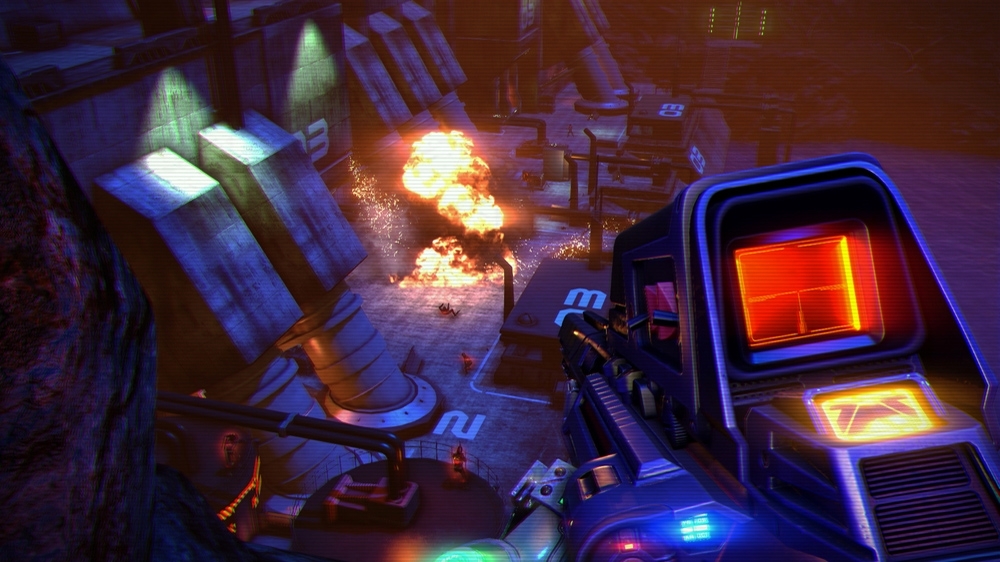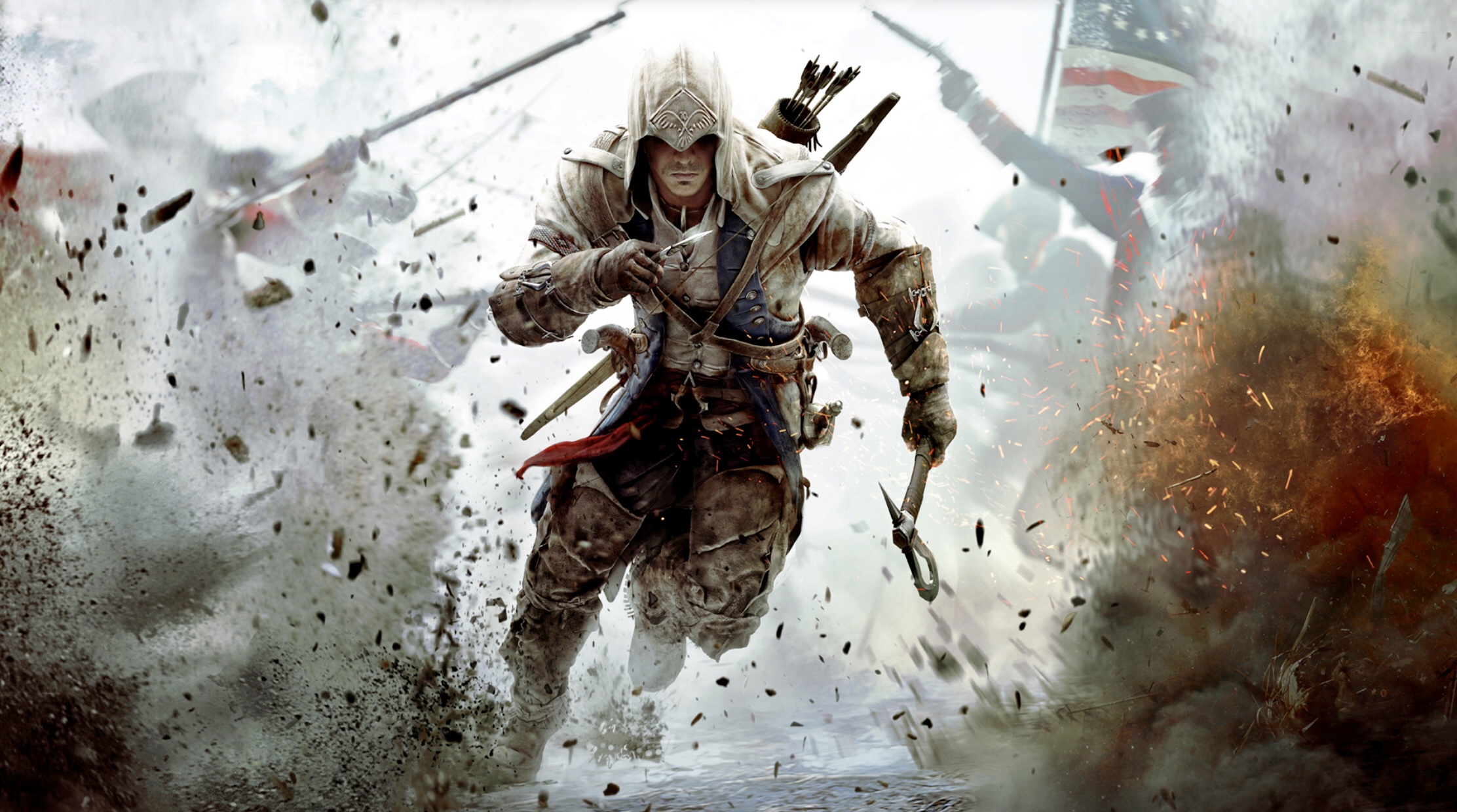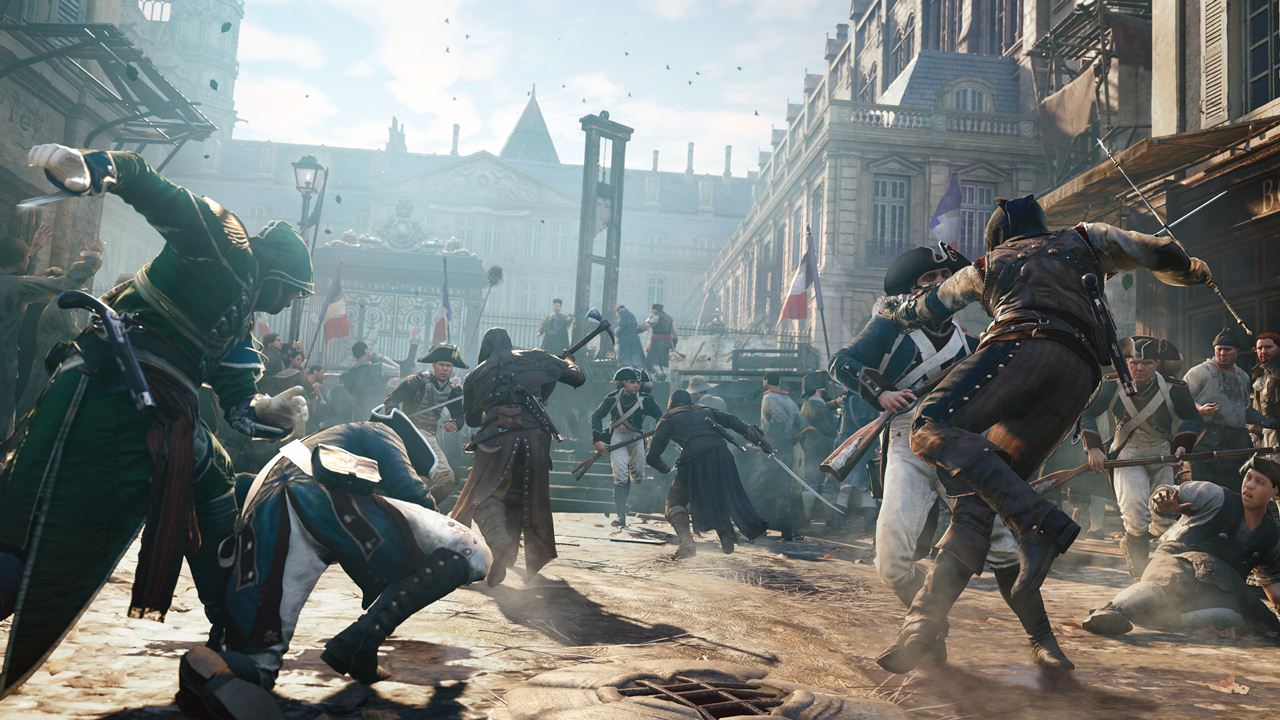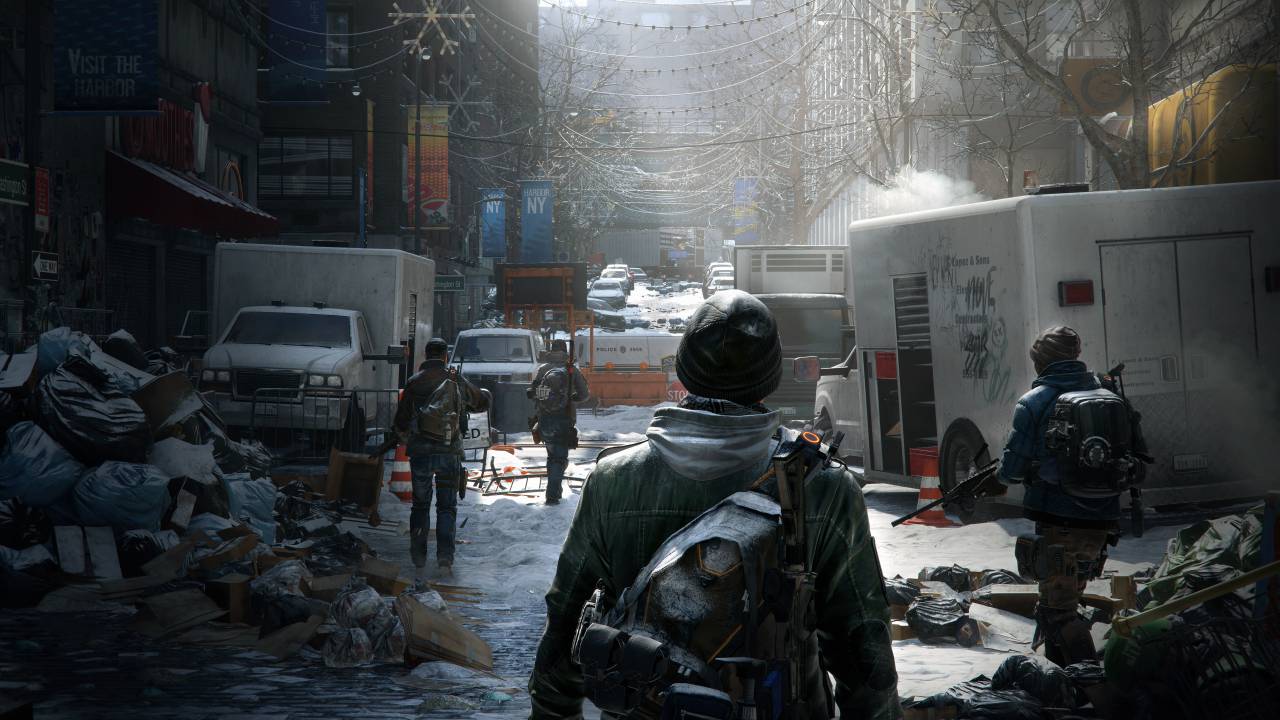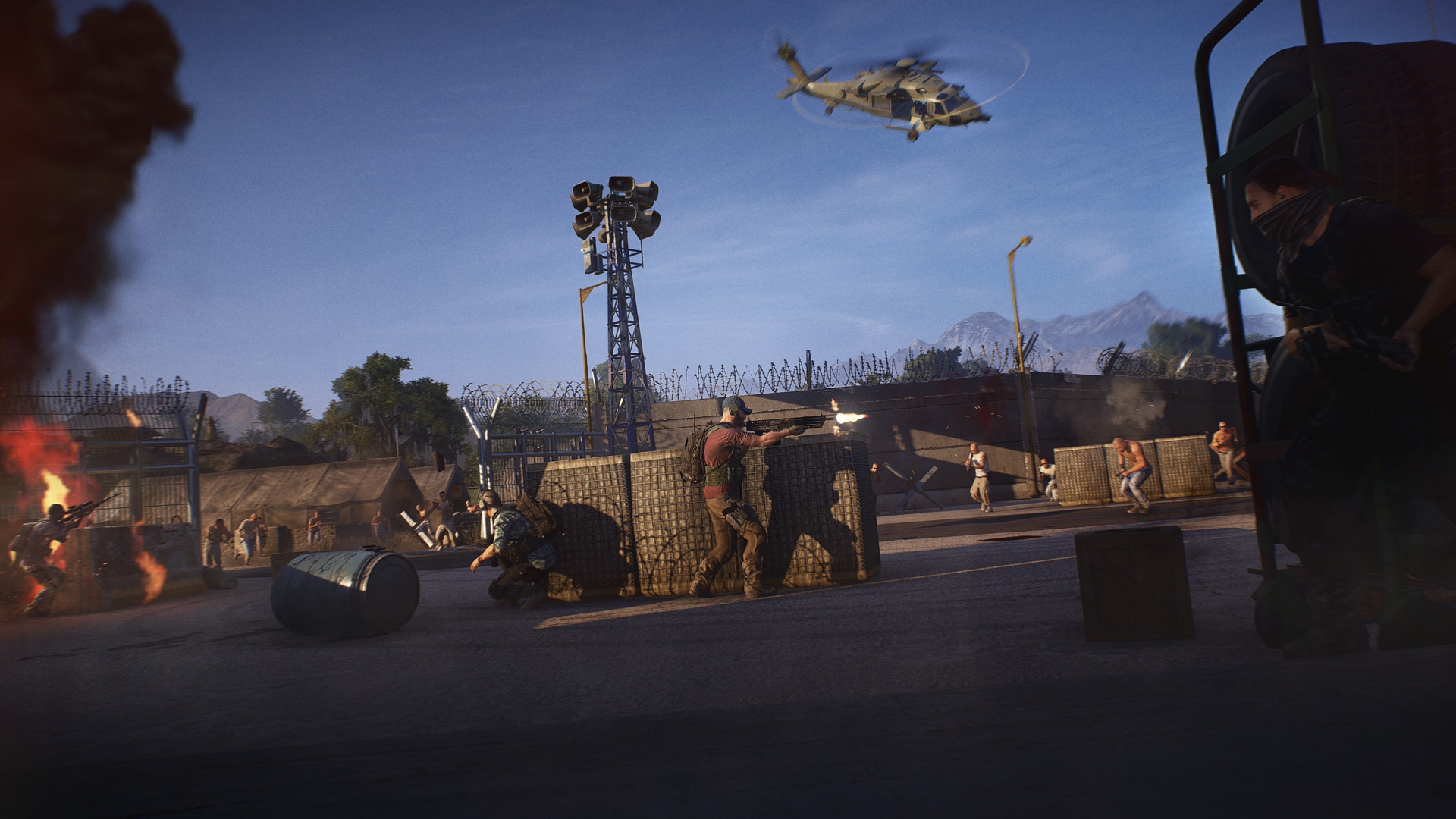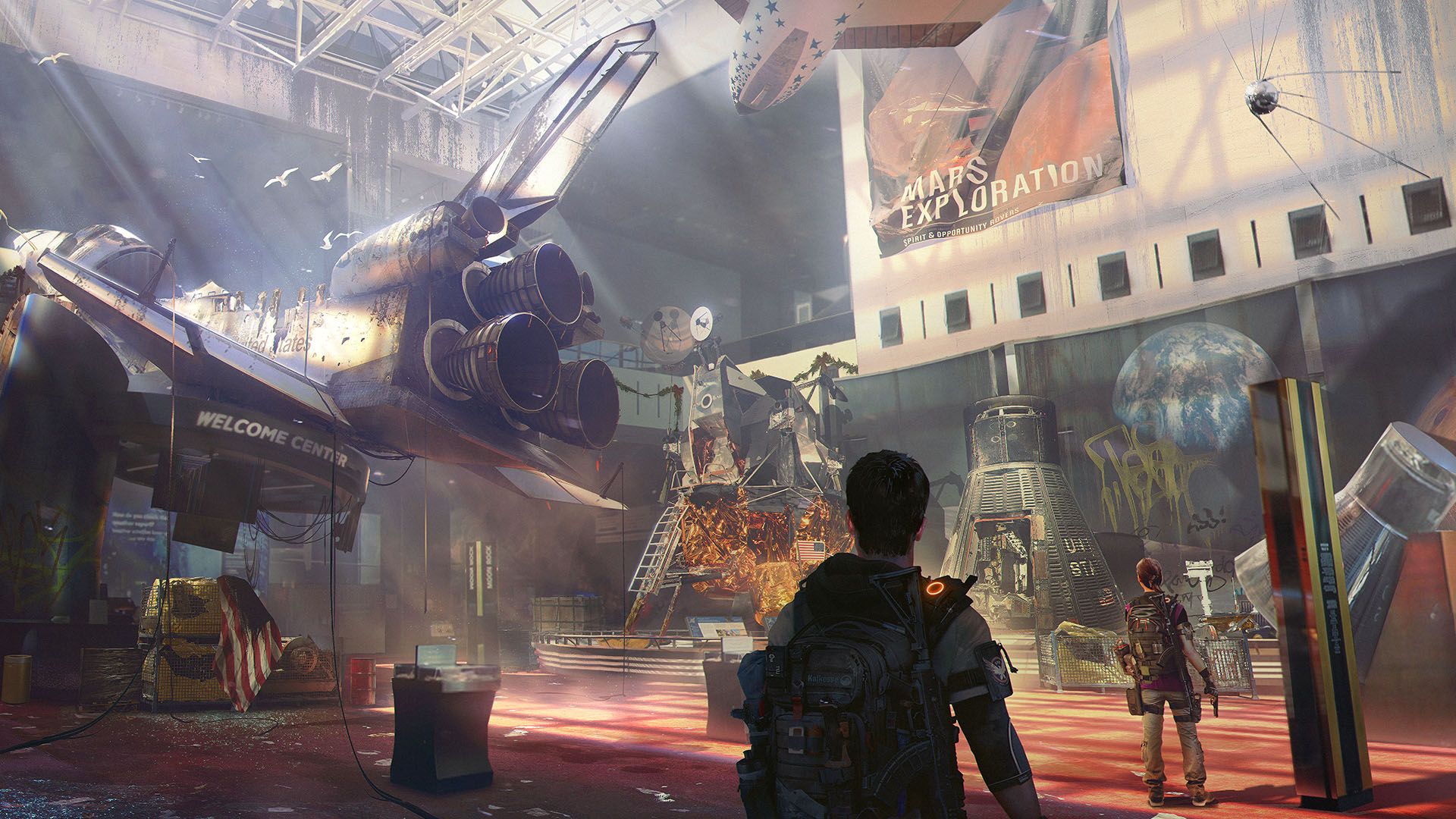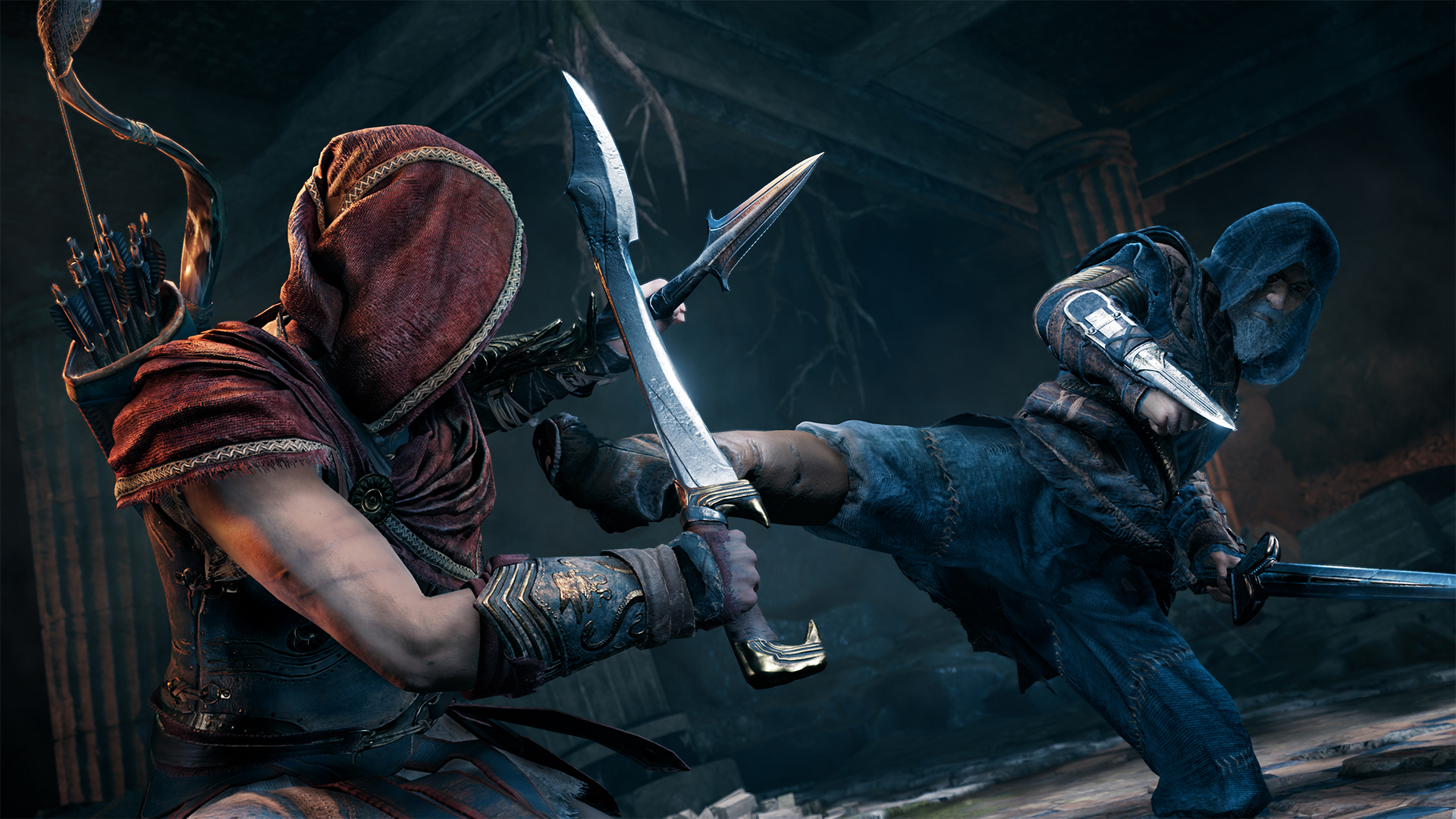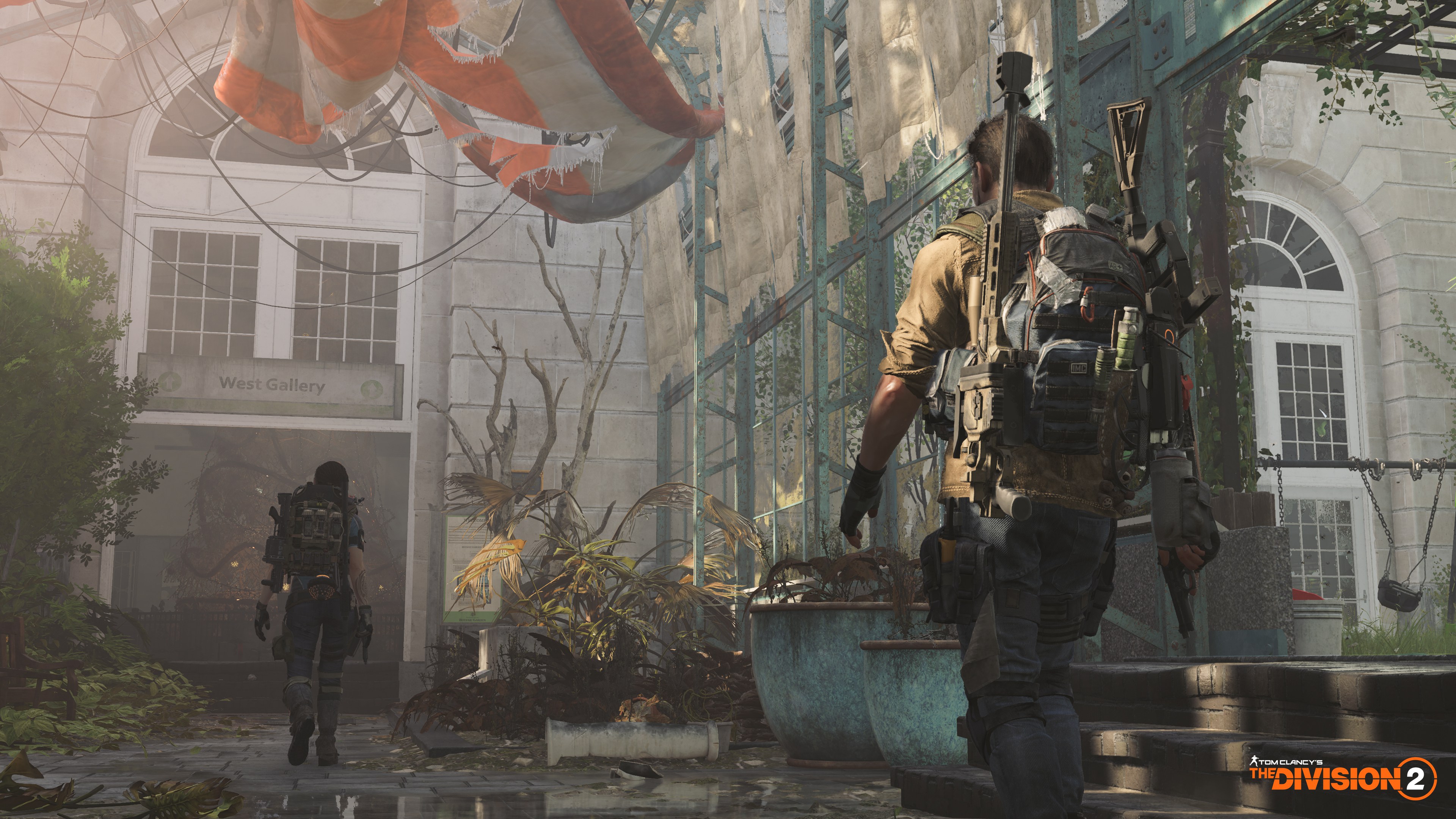
In 2013, Far Cry 3: Blood Dragon was released. Standalone titles that served as quasi-expansions were nothing new at this point but Blood Dragon did offer something different. Harnessing the massive map of Far Cry 3, it churned out a 1980s-style action epic with retro-futuristic visuals and over-the-top story-telling. The dialogue was corny. The neon visuals were extravagantly obscene. More importantly, there was the story-line which focused on the betrayed Rex “Power” Colt and his quest for vengeance against Colonel Sloan.
Sure, it was Far Cry 3’s open world and gameplay that formed the base for Blood Dragon. However, while that game was marketed on the basis of its charismatic antagonist Vaas, Blood Dragon’s charm seeped through every pore of the game’s style and atmosphere. The gameplay itself was no slouch either, removing many of the limitations of Far Cry titles like fall damage and increasing movement speed. Keep in mind that we haven’t even gotten to the part where you ride an armored Blood Dragon with a laser turret in an all-out assault.
"On November 8th 2018, Kotaku journalist Jason Schreier revealed a rather interesting yet unsurprising fact – single-player DLC doesn’t usually sell very well."
Far Cry 3: Blood Dragon wasn’t just a financial success, selling over 1 million copies and becoming the fastest selling downloadable title in Ubisoft’s history. It also stood out as one of the best Far Cry titles ever made, despite essentially reusing an entire map and having a shorter story. We had a feeling at the time that it would influence Ubisoft’s approach to DLC in the future, moving beyond the typical add-ons and expansions, but little did we know by how much.
On November 8th 2018, Kotaku journalist Jason Schreier revealed a rather interesting yet unsurprising fact – single-player DLC doesn’t usually sell very well. Citing a “fair number of developers over the last few years”, Schreier explained that this was the reason that DLC for games like Dishonored 2 and Uncharted 4 would become standalone games, as seen in Dishonored: Death of the Outsider and Uncharted: Lost Legacy respectively. Even Hollow Knight’s upcoming Hornet-focused content was meant to be DLC but eventually expanded into Hollow Knight: Silksong (that’s still being given free to backers of the first game, mind you). So it’s not a scenario that’s isolated to just triple A games. It’s interesting when you think about it in other ways– how many games got ahead of the curb like Grand Theft Auto 5 which focused primarily on delivering GTA Online DLC (especially considering how Grand Theft Auto 4’s Episodes performed in sales)?
It’s a real case-by-case basis though. The Forza series, both Forza Motorsport and Forza Horizon, continue to deliver expansion packs in addition to free content. Forza Horizon 4 actually leaned further into the games-as-a-service model, offering substantial content updates since launch along with expansion packs. Horizon Zero Dawn: The Frozen Wilds is another great example – even if DLC sales weren’t through the roof, Sony is able to offset costs thanks to other factors like hardware sales, console licensing fees, PlayStation Plus revenue, digital sales revenue cuts and much more.
Such a trend could also explain why games-as-a-service has taken such prominence in this day and age. Rewarding continued investment, taking advantage of the sunk-cost fallacy, etc are major factors, make no mistake. After all, why release substantial single-player content that would be tougher to produce and doesn’t provide a continuous revenue stream (forget the fact that many players may not even buy it)? You may be thinking of exceptions like The Witcher 3: Wild Hunt which have seen strong revenue from their post-launch expansions. Keep that in mind as we delve further.
"Games-as-a-service titles aren’t looking to be “one-and-done” like traditional single-player expansions or DLC. They’re meant to be a recurring factor in your gaming life, squeezing out some additional revenue whenever possible."
Games-as-a-service titles are benefiting more from smaller content releases in between substantially larger content drops. Destiny, Destiny 2, Tom Clancy’s The Division, ideally Anthem and Fallout 76, Fortnite, Call of Duty: Black Ops 4, Overwatch and so on are prime examples. Path of Exile follows a set schedule of substantial Challenge Leagues while preparing mega-expansions for release every few years. Warframe’s approach last year saw a big expansion arrive with Fortuna and various smaller content drops since then like newer story episodes, Nightwave and so on. Even Final Fantasy 14: A Realm Reborn, which functions off of a subscription-based model, delivers a major paid expansion every two years. The one thing they all have in common is that they’re multiplayer/social-focused titles and not purely single-player offerings.
Perhaps the one major advantage that games-as-a-service titles have is that they account for players eventually leaving. Keeping them hooked is important, for sure, but the amount of competition in today’s market actually helps players “decompress” from the grinds of of games-as-a-service titles. By the time they return, there are new offerings and hooks to keep them engaged (and possibly spending some money). After all, it’s not like you hate the gameplay of Destiny 2 or Anthem so why not return when some new updates go live? Why not drop some money on Forsaken and the Annual Pass or on Anthem’s cosmetics?
Games-as-a-service titles aren’t looking to be “one-and-done” like traditional single-player expansions or DLC. They’re meant to be a recurring factor in your gaming life, squeezing out some additional revenue whenever possible.
Which makes Ubisoft’s approach to DLC over the past few years so interesting to observe.
"Of course, we all know what happened in 2014. Despite being fairly successful, Watch Dogs faced a firestorm of controversy over its graphical downgrades, bugs and much more."
Let’s go back to Far Cry 3: Blood Dragon. A phenomenal standalone game in its own right but for all intents and purposes, it was DLC. It probably would have been successful as a smaller-scale DLC pack for Far Cry 3 but Ubisoft took a risk, pricing it at $20 and making it a digital-only title.
Things weren’t going too badly for Ubisoft before this. Assassin’s Creed was already a successful yearly sequel franchise – in fact, the publisher was experimenting with releasing a “full-fledged” Assassin’s Creed title and a side game at the time. This would be seen with Assassin’s Creed 3 and Assassin’s Creed 3: Liberation in 2013, and later repeated with Assassin’s Creed Unity and Assassin’s Creed Rogue in 2014. Yes, they were all on different platforms but the fact that they’ve arrived for current gen consoles since then makes Ubisoft’s goal of building a long-term catalog all the more obvious now.
Pre-Blood Dragon, titles were still very much in the traditional DLC cycle. Tom Clancy’s Ghost Recon: Future Soldier received three DLC packs; Trials Evolution only received one DLC pack; and Assassin’s Creed 4: Black Flag received a single-player expansion in Freedom Cry (which would release as a standalone title in February 2014, not-so-coincidentally after the success of Blood Dragon). Despite releasing post-Blood Dragon, Splinter Cell: Blacklist also falls in the same category with its Homeland Pack which only added two new maps, some weapons, and new skins for $6.99. The game released only a few months after Blood Dragon so it makes sense that it would stick to a more old-school DLC model.
Of course, we all know what happened in 2014. Despite being fairly successful, Watch Dogs faced a firestorm of controversy over its graphical downgrades, bugs and much more. It still had Ubisoft’s patented Season Pass with DLC packs but that was pretty overshadowed by all the controversy. Such was the blow-back that it even affected launch week sales of Watch Dogs 2.
"2015 would see Ubisoft truly begin diversifying its DLC portfolio. Tom Clancy’s Rainbow Six: Siege launched and despite receiving heaps of criticism from the outset, it laid the foundation for eventual Yearly Passes."
A similar trend was observed with Assassin’s Creed Unity – it launched in a broken state, had a Season Pass with a main story expansion (Dead Kings), some additional single-player/ content (The Secrets of the Revolution Pack) and two packs with new gear, weapons and outfits (Underground Armory Pack being free and Revolutionary Armaments Pack being paid). Once again, the controversy over Unity’s launch would bleed over into launch week sales for Syndicate besides a general exhaustion with Assassin’s Creed as a franchise.
Granted, Far Cry 4 was better received but the fatigue with Ubisoft’s open world approach was becoming obvious. Far Cry 4 featured a bit more experimentation with its single-player content. Instead of only offering new missions and PvP maps, we also got Escape from Durgesh Prison, a 30 minute race to escape. Completing quests added more time and upgrades while permadeath forced you to restart from the beginning (albeit with any upgrades intact). Valley of the Yetis featured a more robust story component but also introduced base-building and upgrading (which would return as a core mechanic in Far Cry New Dawn). Then you had the standard Hurk Deluxe Pack which added new missions and weapons.
2015 would see Ubisoft truly begin diversifying its DLC portfolio. Tom Clancy’s Rainbow Six: Siege launched and despite receiving heaps of criticism from the outset, it laid the foundation for eventual Yearly Passes. In 2016, Far Cry Primal arrived and served as a standalone title that utilized Far Cry 4’s map. It presented a completely new narrative and mixed up the gameplay significantly by focusing on hunting, older weapons like spears, and warring with other factions. By March 2016, Ubisoft made a major foray into games-as-a-service with Tom Clancy’s The Division.
Though the plan was to initially have three expansion packs and a Season Pass, each expansion was its own self-contained experience. The only real benefit of completing them was for gear that could be carried over into the main game. In terms of narrative and world-building, they had no effect on the base game, not counting minor changes to some existing areas or being able to earn caches containing loot for use in almost all activities.
"Far Cry 5’s approach was a mix of free content updates and an expansion pass that contained three standalone experiences. This could be looked at as trying to create three potential Blood Dragon-like games for the price of one Season Pass."
Underground was a randomly generated set of dungeons; Survival was a battle royale-esque fight for extraction; and Last Stand introduced the game’s first dedicated PvP mode. The main plot-line wasn’t advanced in any significant way but it also meant you didn’t have to own any of the DLC. This became more apparent with Ubisoft’s Year 2 plan which introduced Global Events, Resistance and Skirmish with a brand new area, completely free for all players. Cosmetic-only loot boxes would be subsequently introduced but due to easily earning key fragments and the abundance of outfits as is, most players didn’t take issue with this.
As Rainbow Six: Siege received major improvements to its core gameplay and structure, it introduced its Year 1 Pass. This essentially provided 7 days early access to the new Operators, a Renown boost, Credits for spending in the shop and five daily challenges to earn even more Renown. It wasn’t so much pay-to-win as “pay to get an advance start”. After all, everyone got the new maps for free at roughly the same time. If you were super competitive and wanted to know how the new Operators interacted with these maps, then the pass was for you. Ditto for if you wanted more cosmetics because you were that dedicated to the game,.
Far Cry 5’s approach was a mix of free content updates and an expansion pass that contained three standalone experiences. This could be looked at as trying to create three potential Blood Dragon-like games for the price of one Season Pass. It actually harks back to that Ubisoft survey in 2015 which asked players what they would like to see. A “futuristic, sci-fi setting on another planet” is most likely a reference to Far Cry 5’s Lost on Mars while Hours of Darkness is set during the Vietnam war and Dead Living Zombies takes place during an undead outbreak.
Of course, we recently got Far Cry New Dawn, a standalone title that was actually set several years after the events of Far Cry 5. Though reusing the same map, it had enough new mechanics (including more base-building and outpost attacking) along with a new story to warrant its reduced price point.
"Assassin’s Creed Odyssey took things even further with monthly updates that introduced modes like New Game Plus, free story quests in The Lost Tales of Greece, new cosmetics and gear, level scaling options and so on. That’s in addition to a gargantuan amount of base content."
Cut back to Ghost Recon: Wildlands in 2017 which, again, featured two expansion packs – Narco Road and Fallen Ghosts. Both offered self-contained experiences – you couldn’t transfer equipment and progress to the base game. Meanwhile, the base game would see updates like Special Events, free quests and the addition of Tier 1 Mode for end-game players. For the game’s second year, Ubisoft introduced the Year 2 Pass. This provided cosmetics and early access to new classes in the new Ghost War PvP mode (which was added for free and received additional maps afterwards). It also ensured players had early access to the new Special Operations – special story missions that would crossover into other Ubisoft franchises. The introduction of various tiers of loot boxes also came with the new content updates which were free for everyone.
Remember The Witcher 3: Wild Hunt and its expansions? It seems Ubisoft has found an interesting plan to pursue games-as-a-service in the single-player, open world action RPG space as well. Assassin’s Creed Origins featured an in-game cash shop and added free content over time including Explorer Mode, an editor for PC players to mess about with any setting and Super Bosses to battle for rare loot. It also brought in two expansion packs with new regions and substantial story content.
Assassin’s Creed Odyssey took things even further with monthly updates that introduced modes like New Game Plus, free story quests in The Lost Tales of Greece, new cosmetics and gear, level scaling options and so on. That’s in addition to a gargantuan amount of base content. Even the expansions took a more episodic approach – Legacy of the First Blade was divided into three, easily consumable episodes that introduced new weapons and abilities. As a whole, you could comfortably complete these and then either try out other new features or simply return to the game next month. Once again, you don’t need these expansions to get the most out of Odyssey – the base game already delivers dozens, if not hundreds of hours of content.
It’s an intriguing model, one that combines the games-as-a-service model with single-player expansions but without spending too many resources on brand new regions, dozens of new enemy types, tons of new loot, etc. Through a combination of new gameplay systems like Mastery Progression, balance tweaks, level cap increases and reasons to replay the entire game, Ubisoft is ensuring that fans returning to Odyssey have reason to stay.
"The company has talked about developing games that stick around for several years, seeing substantial updates and growing ever larger as a result (as opposed to a simple yearly sequel strategy)."
Now we have The Division 2 launching with tons of content, ensuring plenty of story and lore for those in it for the long haul along with plenty of end-game opportunities for those seeking the best loot. More content is on the way including World Tier 5, the first raid, the likely introduction of Gear Sets and Episodes containing new story missions, areas and much more. Ubisoft Massive has also promised multiple raids throughout the first year of the game, all free. Of course, there are loot boxes and Year 1 Pass if you want 7 days early access and some goodies but once again, it’s not necessary to avail of the free content.
So to summarize, this is Ubisoft’s current slate of DLC strategies:
- Standalone expansions that reuse a previous game’s assets like map design with new stories, some new mechanics and new characters. Example: Far Cry New Dawn.
- Expansions that don’t much alter the base game (sometimes at all) while also providing dramatically different standalone experiences. Examples: Ghost Recon Wildlands’ Narco Road and Fallen Ghosts, The Division’s Survival and Underground, Far Cry 5’s Season Pass DLC.
- Free content updates and features which often come with updates to the in-game cash shop. Examples: Assassin’s Creed Odyssey, The Division 2.
- Yearly Passes which provide exclusive cosmetics, boosters and early access to new content. Examples: Ghost Recon Wildlands Year 2, Rainbow Six: Siege, The Division 2, For Honor.
- Single-player expansions but broken up into episodes and spread several weeks apart. These introduce new mechanics, weapons and abilities while also remaining baked into the main game. Perhaps the closest to “traditional” single-player DLC. Example: Assassin’s Creed Odyssey.
In this day and age of free to play titles, games-as-a-service titles, triple A releases, multiplayer-centric games and “grind” games, it’s easy to dismiss single-player expansions as being outdated. However, companies like Ubisoft are finding new ways to integrate them into their very large base experiences. The company has talked about developing games that stick around for several years, seeing substantial updates and growing ever larger as a result (as opposed to a simple yearly sequel strategy). This doesn’t mean you won’t see a trend like, say, Assassin’s Creed Odyssey releasing a year after Origins but it does mean that the former will have a much longer shelf-life as a result.
Intrinsically, this creates more potential revenue streams for the company to pursue without having to commit too many resources. On the surface, it heightens the profile of Ubisoft as a company that cares about its games, even if they suffer from a few glitches at launch. But at the end of the day, the plan was to always support some titles in the long-term, even if the method of doing so (see “Operation Health” for Rainbow Six Siege and update 1.3 for The Division) was based off of community feedback and requests.
"All of this is a big step up from the Ubisoft of old, which released technically troubled games to the ire of fans and critics everywhere."
Credit must be given to Ubisoft for improving the overall quality control of its titles at launch as well. However, it’s pretty crazy to see the company branch out into so many different DLC opportunities. It has Yearly Passes for early access to new content, free quests, story expansions, story expansions that serve as standalone games, new areas, new modes, new features, new Operators, the list goes on. And with the company lending its support to Google Stadia, a game streaming platform which promises to eliminate large downloads for the latest updates (among many other things), Ubisoft could be envisioning a future where it can have major triple-A releases on every platform that are supported for years at a time that exist at their own standalone franchises. These would have robust cash shops for those who want to attach additional support to the brand.
All of this is a big step up from the Ubisoft of old, which released technically troubled games to the ire of fans and critics everywhere. While one could criticize this approach as effectively homogenizing several of the company’s properties, stripping away the identity of Assassin’s Creed and Ghost Recon in favour of more generic sandboxes that tick all the open world requirements, Ubisoft has shown an ability to quickly iterate on things that aren’t working. Assassin’s Creed Syndicate released in 2015, for instance, and just two years later, the company reinvented the franchise into an open world action RPG with a heavier emphasis on exploration and choice-driven quests. Keep in mind that this is after Syndicate was well received by critics and eventually saw first-week sales pick up.
Assassin’s Creed Odyssey took the same tenets of Origins but leaned much harder into the action RPG looter approach that defines games like Path of Exile and Warframe while being easier for the vast majority to get into. For a crowd craving more story-based open world RPGs like The Witcher 3: Wild Hunt and Horizon: Zero Dawn, it implemented more choice-based gameplay, dialogue systems and multi-part quests.
No Ubisoft game is without criticism though. Ghost Recon Wildlands’ cosmetic loot boxes and lack of PvE content, complaints of excessive grinding in Assassin’s Creed Odyssey (which would be further exacerbated by the existence of XP boosters), PvP balance concerns in The Division 2, whatever happens to ail Rainbow Six Siege in any given month – the list goes on.
"However you may look at it, this is a intriguing time for Ubisoft. What will the company introduce next and how long will it leverage current models of content delivery?"
Imagine the support structure and community teams required to constantly address PvE vs. PvP balance and loot droprates in The Division 2 or balance concerns and story direction choices in Assassin’s Creed Odyssey. Compared to the days of haphazard development on Assassin’s Creed 4: Black Flag, it’s almost miraculous that Ubisoft is delivering post-launch content and new games at such a fast pace while also trying new things like Starlink: Battle for Atlas, Mario + Rabbids: Kingdom Battle and the upcoming Skull and Bones.
Ubisoft has also shown an apt hand at staying ahead of the monetization curb while still appealing to and retaining the vast majority of consumers. There’s probably something to be said about the company leaning much more into open world titles with boat-loads of content. Does all that content make for a better experience on a narrative and gameplay level or is it simply there to ensure all kinds of players have something to do? Is Assassin’s Creed Odyssey a better game because it caters to story-hungry fans while also having random contracts, gear grinding, best-in-slot optimization, fetch quests, large Conquest battles and so on? For that matter, is The Division 2 served better as a looter shooter by including so many random activities to complete along with social activities instead of a more narrative-focused, single-player campaign with optional co-op? Perhaps a discussion for another day.
However you may look at it, this is a intriguing time for Ubisoft. What will the company introduce next and how long will it leverage current models of content delivery? What does the future hold especially as conversations about crunch culture and the like keep happening? How will Ubisoft leverage deals with storefronts like the Epic Games Store and strengthen its own brand at the same time? Time will tell but if you have even a passing interest in the majority of Ubisoft’s offerings, chances are you’ll be in it for the long haul. And in age where the usual expansions don’t quite cut it in terms of revenue, what more could a major triple A publisher want?
Note: The views expressed in this article are those of the author and do not necessarily represent the views of, and should not be attributed to, GamingBolt as an organization.








